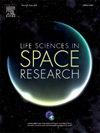CELSS 180 天综合实验期间的固体废物管理和资源回收
IF 2.8
3区 生物学
Q2 ASTRONOMY & ASTROPHYSICS
引用次数: 0
摘要
为了探索未来月球基地可控生态生命支持系统(CELSS)中固体废物的管理和处理方法,在 4 人 180 天的综合实验中,建立了固体废物管理和处理系统(SWMTS),通过生物好氧堆肥和高温氧化相结合的方法,完成对不可食用植物部分和人类排泄物等可回收固体废物的处理。在 4 个机组人员 180 天的实验任务中,获得了固体废物种类和数量的基本数据。固体废物共有六种,包括工作辅助废物、生活辅助废物、植物栽培废物、植物性废物和机组人员粪便。日均产生量分别为 0.67、1.4、0.32、8.48、0.534 千克/天。植物性废物所占比例高达 74.3%,表明它是最重要的部分。通过闭环空气干燥和分级破碎,1526.97 千克的植物性废物得到了处理,并回收了水分(约 1163.87 千克),同时还进行了减容和稳定化处理。通过焚烧和好氧堆肥处理,67.3%(244.4 千克)的植物性废物(干重)和全部粪便(96.26 千克)得到转化,为植物生长提供了 339.54 千克二氧化碳。此外,还获得了 90.6 千克有机肥料。肥料成熟度高,符合安全要求,有效提高了生菜产量。试验期间,可再生固体废弃物的回收率达到 89.8%。在 4 人 180 天的综合实验中,实现了固体废弃物的高效循环。长期的实验结果表明,所建立的固体废弃物管理和处理系统能够及时处理植物的不可食用部分和船员粪便等生物质固体废弃物,及时回收这些固体废弃物中的水分,并循环利用碳和其他元素,有效提高了系统的物质封闭性,确保了 4 船 180 天实验的成功。这项工作也可能为未来月球基地生态生命支持系统的建设和运行奠定基础。本文章由计算机程序翻译,如有差异,请以英文原文为准。
Solid waste management and resource recovery during the 4-crew 180-day CELSS integrated experiment
In order to explore the management and treatment methods of solid waste in the Controlled Ecological Life Support System (CELSS) of future lunar bases, during the 4-crew 180-day integrated experiment, the Solid Waste Management and Treatment System (SWMTS) was built, in which the treatment of recyclable solid waste such as inedible plant parts and human excrement was completed through a combination of biological aerobic composting and high-temperature oxidation. Basic data on the types and amounts of solid waste generated during the 4-crew 180-day experiment mission were obtained. There were six types of solid wastes, including the work support wastes, the household support wastes, the plant cultivation wastes, the plant-based wastes, and crew feces. The daily average production was 0.67, 1.4, 0.32, 8.48, 0.534 kg/d, respectively. The proportion of plant-based wastes was high as 74.3 %, indicating that it was the most important part. By closed-loop air drying and graded crushing, all 1526.97 kg of plant-based waste was treated, with water recovery (about 1163.87 kg), as well as volume reduction and stabilization treatment. By incineration and aerobic composting treatment, 67.3 % (244.4 kg) of the plant-based wastes (dry weight) and all of the feces (96.26 kg) were converted, providing 339.54 kg carbon dioxide for plant growth. And 90.6 kg organic fertilizer was obtained. The fertilizer was highly mature, met safety requirements, and effectively improved lettuce yield. The recycling rate of renewable solid waste during the experiment reached 89.8 %. The efficient circulation of solid waste had been achieved during the 4-crew 180-day integrated experiment. The long-time experimental results have shown that the established solid wastes management and treatment system can timely treat biomass solid waste such as inedible parts of plants and crew feces, achieve timely recovery of water in such solid waste, and recycle carbon and other elements, which effectively improved the material closure of the system and ensured the successful 4-crew 180-day experiment. This work also maybe lay the foundation for the construction and operation of an ecological life support system for future lunar bases.
求助全文
通过发布文献求助,成功后即可免费获取论文全文。
去求助
来源期刊

Life Sciences in Space Research
Agricultural and Biological Sciences-Agricultural and Biological Sciences (miscellaneous)
CiteScore
5.30
自引率
8.00%
发文量
69
期刊介绍:
Life Sciences in Space Research publishes high quality original research and review articles in areas previously covered by the Life Sciences section of COSPAR''s other society journal Advances in Space Research.
Life Sciences in Space Research features an editorial team of top scientists in the space radiation field and guarantees a fast turnaround time from submission to editorial decision.
 求助内容:
求助内容: 应助结果提醒方式:
应助结果提醒方式:


